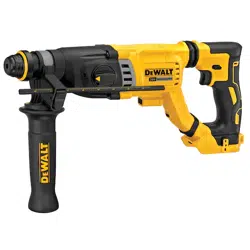Loading ...
Loading ...
Loading ...

ENGLISH
9
Trigger Switch (Fig. A)
To turn the tool on, squeeze the trigger switch
2
. To turn
the tool off, release the trigger switch. Your tool is equipped
with a brake. The chuck will stop as soon as the trigger
switch is fullyreleased.
Variable Speed Trigger Switch
The variable speed trigger switch enables you to select
the best speed for a particular application. The farther you
squeeze the trigger switch, the faster the tool will operate.
For maximum tool life, use variable speed only for starting
holes orfasteners.
NOTE: Continuous use in variable speed range is not
recommended. It may damage the trigger switch and
should beavoided.
Worklight (Fig. A)
CAUTION: Do not stare into worklight. Serious eye
injury could result.
There is a worklight
7
located on the tool. The worklight
is activated when the trigger switch is depressed, and will
automatically turn off 20 seconds after the trigger switch
is released. If the trigger switch remains depressed, the
worklight will remainon.
NOTE: The worklight is for lighting the immediate work
surface and is not intended to be used as aflashlight.
Forward/Reverse Control Button (Fig. A)
A forward/reverse control button
3
determines the
direction of bit rotation and also serves as a lock-offbutton.
To select forward rotation, release the trigger switch
2
and depress the forward/reverse control button on the right
side of thetool.
To select reverse, depress the forward/reverse control
button on the left side of thetool.
The center position of the control button locks the tool
in the off position. When changing the position of the
control button, be sure the trigger isreleased.
NOTE: The first time the tool is run after changing the
direction of rotation, you may hear a click on start up. This is
normal and does not indicate aproblem.
SHOCKS® Active Vibration Control System
For best vibration control, hold the tool as described in
Proper Hand Position and apply just enough pressure so
the damping device on the main handle is approximately
mid stroke. The hammer only needs enough pressure to
engage the active vibration control. Applying too much
pressure will not make the tool actuate faster and active
vibration control will notengage.
ASSEMBLY AND ADJUSTMENTS
WARNING: To reduce the risk of serious personal
injury, turn unit off and remove the battery pack
before making any adjustments or removing/
installing attachments or accessories. An
accidental start-up can causeinjury.
Side Handle (Fig. D)
WARNING: To reduce the risk of personal injury,
ALWAYS operate the tool with the side handle
properly installed. Failure to do so may result in
the side handle slipping during tool operation and
subsequent loss of control. Hold tool with both hands
to maximizecontrol.
The side handle
1
clamps to the front of the gear case and
may be rotated 360˚ to permit right- or left-hand use.
Mounting the Straight Side Handle
(Fig. D)
1. Widen the ring opening of the side handle
1
by
rotating it counterclockwise.
2. Slide the assembly onto the nose of the tool, through
the steel ring
11
and onto the collar
12
, past the chisel
holder andsleeve.
3. Rotate the side handle assembly to the desired position.
For hammerdrilling horizontally with a heavy drill
bit, place the side handle assembly at an angle of
approximately 20° to the tool for optimumcontrol.
4. Lock the side handle mounting assembly in place by
rotating the handle clockwise.
Fig. D
12
1
11
Depth Rod (Fig. E)
To Adjust the Depth Rod
1. Push in and hold the depth rod release button
14
on
the side handle.
2. Move the depth rod
13
so the distance between the
end of the rod and the end of the bit equals the desired
drilling depth.
3. Release the button to lock rod into position. When
drilling with the depth rod, stop when end of rod
reaches surface of material.
Loading ...
Loading ...
Loading ...
